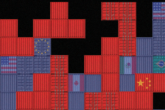December 02, 2020
Sanctions by the Numbers: Spotlight on China
The United States has significantly increased its sanctions designations on Chinese individuals, entities, and ships in 2020. While the United States has imposed sanctions on Chinese entities and individuals for many years, these past actions were usually part of sanctions regimes that targeted other states, such as Chinese companies trading with North Korea or Iran, or non-state actors, like criminals and drug traffickers. However, as U.S.-China relations have deteriorated over the course of 2020, the United States has directly targeted Chinese entities and individuals with sanctions. This includes naming Chinese officials associated with systemic human rights abuses and territorial aggression in the region. While the bulk of currently sanctioned Chinese individuals and companies are still primarily linked to China’s facilitation of activities from other countries, recent targeting has shifted sharply to focus on China more directly.
Total Designations against Chinese Individuals and Entities by Program Targets, 2001–2020
Source: Historical data from 2001–2020 from the U.S. Department of the Treasury’s Office of Foreign Assets Control
This graph shows the total number of designated Chinese entities from 2001 to the present, organized by sanctions program. The majority of Chinese entities sanctioned (64 percent) were designated for ties to Iran and North Korea.
Sanctions Designations of Chinese Individuals and Entities by Target, 2001–2020
Source: Historical data from 2001–2020 from the U.S. Department of the Treasury’s Office of Foreign Assets Control
After sanctioning only one Chinese official over the past 20 years, the United States has dramatically increased designations of Chinese officials since July 2020.
Sanctions Designations of Chinese Individuals and Entities
Source: Historical data from 2001–2020 from the U.S. Department of the Treasury’s Office of Foreign Assets Control
The United States significantly increased designations of Chinese actors under the Trump administration. The number of designations reached a record high in 2017, and again in 2020. Compared to the Trump administration’s recent focus on human rights violations, 93 percent of designations under the Bush administration were based on ties to terrorist groups or states on the State Sponsors of Terrorism list, while 68 percent of designations under the Obama administration were based on counterproliferation programs.
Number of Human Rights–Related Sanctions Designations of Chinese Individuals and Entities
Source: Historical data from 2001–2020 from the U.S. Department of the Treasury’s Office of Foreign Assets Control
Until 2017, no human rights–related sanctions were imposed on any Chinese entities. However, the number of human rights–related sanctions has sharply increased over the past year as U.S.-China relations have deteriorated. These designations are primarily related to the state-led repression in Xinjiang and Hong Kong.
Crime-Related Sanctions Designations of Chinese Individuals and Entities
Source: Historical data from 2001–2020 from the U.S. Department of the Treasury’s Office of Foreign Assets Control
Over the past two decades, the number of designations of Chinese entities for organized crime and drug trafficking has been inconsistent. However, as with the recent rise in Chinese designations under human rights authorities, the Trump administration has noticeably increased designations of Chinese entities for criminal activities over the past several years as bilateral relations have cooled. The United States imposed a total of 19 designations in the past three years. In contrast, over the course of 16 years, the Bush and Obama administrations made only seven and eight designations, respectively.
Methodology
The following sanctions programs were included: NPWMD, SDGT, 561List, IFSR, SDNTK, SYRIA, DPRK2, DPRK3, DPRK4, TCO, CAATSA-RUSSIA, IRAN, IRAN-EO13846, IRAN-13871, IFCA, CYBER2, GLOMAG, and HK-EO13936. In cases where the sanctions program was designed to be open instead of tailored to target a specific state or non-state entity, determining if the entities were based in China and/or directly tied to the Chinese government demonstrated that Chinese entities were the primary targets. For example, the Union Development Group is listed as being based in Cambodia but was designated under GLOMAG because it is a Chinese state-owned enterprise. As a result, its designation was included in this analysis.
This is the fourth installment in the Sanctions by the Numbers series. Click here to read the first installment on U.S. sanctions designations and delistings by Johnpatrick Imperiale, here to read the second installment on global distribution of U.S. sanctions, and here to read the third installment on Iran sanctions, both by Abigail Eineman.
As a research and policy institution committed to the highest standards of organizational, intellectual, and personal integrity, CNAS maintains strict intellectual independence and sole editorial direction and control over its ideas, projects, publications, events, and other research activities. CNAS does not take institutional positions on policy issues and the content of CNAS publications reflects the views of their authors alone. In keeping with its mission and values, CNAS does not engage in lobbying activity and complies fully with all applicable federal, state, and local laws. CNAS will not engage in any representational activities or advocacy on behalf of any entities or interests and, to the extent that the Center accepts funding from non-U.S. sources, its activities will be limited to bona fide scholastic, academic, and research-related activities, consistent with applicable federal law. The Center publicly acknowledges on its website annually all donors who contribute.
More from CNAS
-
Sanctions by the Numbers: The Geographic Distribution of U.S. Sanctions
In February, CNAS launched Sanctions by the Numbers, a project to track U.S. sanctions designations and delistings. In this second installment, heat maps show the most heavily...
By Abigail Eineman
-
A New Arsenal for Competition
Executive Summary The United States and China have long used coercive economic measures to advance both economic and foreign policy objectives. In recent years, however, both ...
By Elizabeth Rosenberg, Peter Harrell & Ashley Feng
-
Sanctions by the Numbers: Spotlight on Iran
This edition of Sanctions by the Numbers explores Iran sanctions, tracking how designations and delistings have evolved over time, the dozens of countries affected by Iran-rel...
By Abigail Eineman
-
Game Over?
The trade wargame suggests that sustained high tariffs could create leverage and urgency to spur action toward a productive restructuring of the international trade system....
By Emily Kilcrease & Geoffrey Gertz










